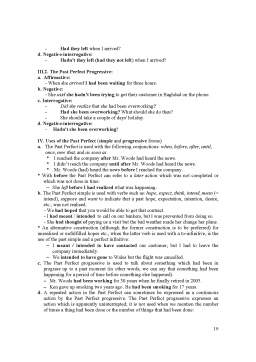Extras din curs
Basic Contrasts: Present Simple and Present Continuous/Progressive
1. Present simple generally refers to:
- Facts that are always true:
E.g. Water boils at 100 degrees Celsius.
- Habits related to the present reality:
E.g. British people drink a lot of tea.
- States:
E.g. I don’t like pineapple.
2. Present continuous (progressive) generally refers to actions which are in
progress at the moment of speaking “now”.
- These actions can be temporary:
E.g. I’m working at that company until I find a new job.
- They can be actually in progress:
E.g. What is John doing?
He’s talking to our newly appointed Marketing Director.
- They can be generally in progress but not actually happening at the
moment:
E.g. I’m learning to drive.
State verbs and event verbs (action/dynamic verbs)
1. State verbs describe a continuing state, so do not usually have a continuous
form. Typical examples are:
be, depend, feel, have, measure, see, taste, think, weigh
Compare these uses:
State verbs Event verbs
Tom is noisy. John is being noisy.
You have a new Ferrari. They are having an attention-grabbing chat.
I think he is right. Ann is thinking about getting a new job.
This fish tastes awful! She is just tasting the soup.
I feel that you’ll be successful. I am feeling terrible.
This suitcase weighs a ton! They are weighing the baby.
It depends what you mean. They are depending on their baby-sitter.
Other uses of present continuous
1. Temporary or repeated actions. This use emphasises a temporary action or a
repeated habitual action happening in a larger present.
E.g. My car has broken down, so I am walking to work these days.
Are you enjoying your stay here?
2. Complaints about bad habits.
E.g. Your boss is always speaking much too much on the phone.
Other possible adverbs are: constantly, continually, forever.
3. With verbs describing change and development.
E.g. Things are getting worse.
More and more people are giving up smoking.
4. Definite arrangements in the near future (and it is the most usual way of
expressing one’s immediate plans). It is also used in questions related to
socialising and travelling activities.
E.g. I’m going to the theatre tonight (this would almost certainly imply that
the tickets have been bought).
Ann: Are you doing anything tonight?
Mary: Yes, I’m going to my judo class and (I’m) meeting my parents
afterwards.
Other uses of present simple
1. Making declarations.
Verbs describing opinions and feelings tend to be state verbs.
E.g. I hope you’ll come to my party.
I bet you don’t know the answer!
2. Headlines.
These are written in a ‘telegram’ style, and references to the past are usually
simplified to present simple.
E.g. Plane crashes mysteriously near Paris.
3. Instructions and itineraries.
Instructions and recipes can be written in present simple instead of in
imperative forms. This style is more personal.
E.g. First you roll out the pastry.
Itineraries are descriptions of travel arrangements.
E.g. On day five we visit the Louvre Museum in Paris.
Preview document
Conținut arhivă zip
- The Indicative Mood.pdf

















































